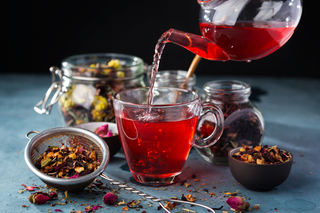One of the most exciting herbal remedies for the budding herbalist is tea. Most people in the world have had tea, and think they know what “making tea” entails. But once you start learning about traditional herbal preparations, you discover that good tea is so much more than just plopping a tea bag in some hot water and sipping away. Traditional tea making is an art, and we are here to teach you the ins and outs of the perfect cup of tea.
The Loose Leaf Difference
First, let's talk boxed tea. This is how most consumers expect to purchase tea; in individually packaged tea bags lined up in a box. While boxed tea is a bit more consumer friendly, this excessive packaging generates unnecessary waste and quickly degrades the potency of its contents.
Fun fact: When harvesting and drying your herbs, it is recommended to consume them within a year of the harvest date.
Sure, most tea companies have sell-by dates but, let's be honest, how old is that box of earl gray tea that’s sitting in your cupboard? Plus, tea bags require very finely ground herbal material. Once plant matter is ground down this fine, it oxidizes (degrades) very quickly. Considering this, how much will that tea really support you when you need it most?
Here at Doctor Morse's, all our teas are “loose leaf,” meaning that we leave the herbs more coarsely ground and loose in a pouch with each serving measured by the teaspoonful. Packing our tea this way keeps our herbs fresher and, in turn, more potent. Shop Doctor Morse’s full tea line here.
Water as a Solvent
Spoiler alert: tea is made with water. Water is the most widely used and readily available solvent for extracting herbs. This polar molecule is excellent at extracting many of the plants' therapeutic properties such as minerals, mucilage, bitters, volatile (essential) oils, polysaccharides and vitamins. Plus, water is quickly absorbed by the body, aiding in the quick absorption of your herbs!
One drawback to water as a solvent is its short shelf life; tea will not keep for long without refrigeration, and even with refrigeration will not last more than a few days.
Traditional Herbal Tea
Traditional Western Herbalists identify 4 ways to make tea:
- Decoction
- Cold Infusion
- Hot Infusion
- Tisane
Decoctions
are reserved for roots, bark, seeds and hard berries. These herbs need heat and time to soften enough to lend their phytochemistry to the tea water. For this reason, decoctions are simmered for 7-15 minutes before straining and drinking. All Doctor Morse's tea blends may be prepared as decoctions because they contain a blend of herbs, roots, barks and seeds.
Plant Part: Roots, barks, hard seeds & berries.
Proportions: Doctor Morse’s tea blends suggest 1 teaspoon of herbal tea blend to 2 cups of water.
Preparation: Add herbs to cold water in a saucepan. Bring water to a boil (150 – 180 degrees F) then immediately reduce to a simmer and cover.
Steep Time: 7 – 30 minutes or more. You can also use decocted tea water to make a hot infusion by adding any leaves and/or flowers to your decoction once you turn off the heat. Use a hand-held metal strainer to remove herbs from tea water.
Cold Infusions
use cold to room temperature water to specifically target mucilaginous polysaccharides. These molecules are extremely hydrophilic (water loving), swelling as they encounter water, resulting in a thickening, hydrating effect.
Mucilaginous herbs: Marshmallow root, Licorice root, Cinnamon bark, Fenugreek seed, Chia seed, Flax seed, Comfrey root, Irish moss.
Proportions: 1 – 3 teaspoons dry herb to 1 cup water.
Preparation: Place herbs in a quart jar, cover with cold water and cap.
Steep Time: 5 - 8 hours or overnight. You can leave your infusion in the refrigerator to enhance this process. To strain, hand-held metal strainers are best.
This is an alternative way to prepare Doctor Morse's Stomach Tea.
Hot Infusions
are for softer plant parts, such as leaves and flowers. These plant parts easily lend their supportive phytochemicals to the hot water without any type of agitation. You simply measure out your tea blend, pour hot water over it, place a lid on your infusion and let it steep.
Plant Part: Leaves and flowers (aerial parts of the plant) and some aromatic seeds.
Proportions: General rule of thumb is 1 – 3 teaspoons dry herb to 1 cup water.
Preparation: Bring water to a boil (180 – 210 degrees F), pour the hot water over your herbs, cover and steep.
Steep Time: 15 minutes to 1+ hour(s). To strain, use a French press, tea ball, muslin tea bags or metal strainers. Enjoy up to three cups daily.

Tisane
is a French word that can be used to describe all herbal tea, but it is also taught by many Western Herbalists to be a tea made with only fresh herbs.
Plant Part: All freshly harvested herbs.
Proportions: General rule of thumb is 1 – 3 teaspoons dry herb to 1 cup water.
Preparation: Bring water to a boil (150 – 180 degrees F), pour the hot water over your herbs, cover and steep.
Steep Time: 15 minutes to 1+ hour(s). To strain, use a French press, tea balls, muslin tea bags or metal strainers. Enjoy up to three cups daily.
Cover Your Tea!
Keeping your tea covered is a very important step when preparing any tea, be it boxed or loose leaf. Herbs are loaded with volatile oils. The definition of a volatile is something that evaporates easily at room temperature. These therapeutic volatile oils will hitch a ride on steam vapor right out of your cup! The result will be a lovely smelling kitchen and a tea void of its therapeutic properties. This is why it is so important to keep your tea covered during the steeping process.
Many of our classic tea herbs such as peppermint, spearmint, lavender, tulsi, rosemary, basil, and skullcap are mint (lamiaceae) family members. This plant family is loaded with volatile oils and studies show how these oils support a calm nervous system.*
Practice the traditional art of making tea as a self-care meditation. Preparing tea the traditional way may feel a bit more complex and time consuming, but in our fast-paced world, stopping to make a tasty cup of herbal tea may be just the ticket to a more fulfilling day.
*FDA warning: This statement has not been evaluated by the Food and Drug Administration. This product is not intended to diagnose, treat, cure, or prevent any disease.



Lynis
Thanks for this information it is very helpful.
Retinella
Never too old to learn. Thank you Dr. Morse. I did not know the reason behind covering your tea while preparing.
Molly
I love the tea components
Esther
Thank you! I needed that.
Big B
Excellent article, thanks so much for sharing this.
GOD Bless 🙏🏻